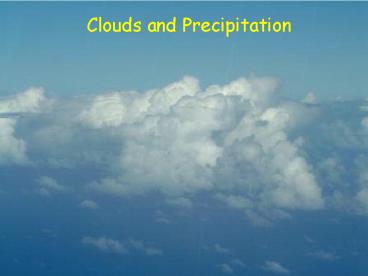Clouds and Precipitation - PowerPoint PPT Presentation
1 / 20
Title:
Clouds and Precipitation
Description:
From Global Precipitation Climatology Project. 13. 14. Extreme Events: ... From International Satellite Cloud Climatology Project. Clouds and cloud cover. 19. 20 ... – PowerPoint PPT presentation
Number of Views:493
Avg rating:3.0/5.0
Title: Clouds and Precipitation
1
Clouds and Precipitation
2
Clausius-Clapeyron Relationship
A 1 K increase in temperature causes es to
increase by 6.5
An air parcel at 50 RH must cool 10 K to reach
saturation
3
Why might RH be constant in a warming climate?
Not just CCdepends on air parcel trajectory and
how RH is controlled
Evaporation rate does not necessarily increase
b/c windspeed and RH also are factors, not just
temperature
Pierrehumbert et al. (2007)
4
Making a cloud
5
Making a cloud
Global circulation patterns play a key role.
6
From Global Precipitation Climatology Project
7
Spring
Winter
Summer
Fall
8
Precipitation
9
Precipitation in a warmer climate
If RH is conserved
Amount of water in an air mass is greater
For a given DT more water is condensed
10
How is precipitation changing?
No clear global trend in land precipitation
Mainly based on rain gauge measurements
Year
IPCC AR4 Fig. 3.12
11
Regional Precipitation Change
Wet areas get wetter, dry areas get drier
These are land-based measurements
Zhang et al., Nature (2007)
12
From Global Precipitation Climatology Project
13
(No Transcript)
14
Extreme Events Tropical Cyclones
Strong multi-decadal fluctuations makes
determination of trends very difficult.
of tropical cyclones may be increasing (but not
necessarily landfall)
Intensity changes of hurricanes unknown
Total
Not so bad.
Oh no!!!
Holland (2007)
Mann et al. EOS (2007)
15
Clouds and cloud cover
Land only
IPCC, AR4
16
Land vs. Ocean Clouds
Trap LW
Reflect SW
visual observation
satellite
Trap LW
Reflect SW
Norris, JGR (2005)
17
Global Mean Ocean Clouds
5 per century
Iishi et al. J. Int. Climat. (2005)
18
Clouds and cloud cover
From International Satellite Cloud Climatology
Project
19
(No Transcript)
20
Evapotranspiration vs. Pan Evaporation
1. Declining trend in pan evaporation
- depends predominately on radiation energy input
2. Increasing trend in evapotranspiration
- Depends on radiation and availability of water
in the soil (i.e. precipitation patterns)
Peterson, Nature (1995)































